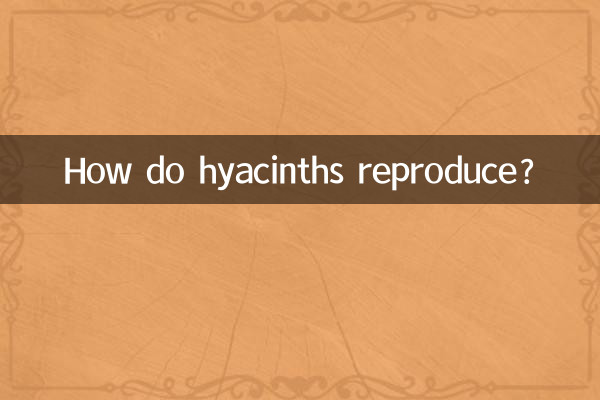How do hyacinths reproduce?
Hyacinth is a beautiful and fragrant spring flower beloved by gardening enthusiasts. The main methods of propagating hyacinth include bulb propagation, seed propagation and tissue culture. This article details these methods and provides relevant data and considerations.
1. Split-ball propagation

Ball propagation is the most common propagation method for hyacinths. It is simple to operate and has a high success rate. The following are the steps for ball propagation:
| steps | Operating Instructions |
|---|---|
| 1. Select the cue ball | Choose a healthy, disease-free cue ball with a diameter generally above 5 cm. |
| 2. Separate ion spheres | Dig out the cue ball in the fall and gently separate the attached pellets. |
| 3. Disinfection | Soak the balls in carbendazim solution for 10 minutes, dry and set aside. |
| 4. Planting | Plant the seed bulbs in loose, well-drained soil at a depth twice the height of the bulbs. |
| 5. Maintenance | Keep the soil moist and avoid waterlogging for spring blooms. |
2. Seed propagation
Seed propagation is suitable for cultivating new varieties, but the cycle is longer and generally takes 3-4 years to bloom. Here are the steps for seed propagation:
| steps | Operating Instructions |
|---|---|
| 1. Collect seeds | After the flowering period is over, collect the ripe seeds. |
| 2. Sow seeds | Spread the seeds in a seedling tray and cover with a light layer of soil. |
| 3. Moisturizing | Keep the soil moist and control the temperature at 15-20°C. |
| 4. Transplanting | After the seedlings grow 2-3 true leaves, transplant them to a flower pot or garden. |
| 5. Maintenance | Fertilize regularly and flowering will occur in 3-4 years. |
3. Tissue culture
Tissue culture is a highly efficient propagation method suitable for large-scale production, but requires specialized equipment and skills. Here are the steps for tissue culture:
| steps | Operating Instructions |
|---|---|
| 1. Obtain materials | Select healthy shoot tips or scales as explants. |
| 2. Disinfection | Disinfect explants with alcohol and mercury chloride solution. |
| 3. Vaccination | Explants were inoculated into MS medium. |
| 4. Cultivate | Culture at 25°C and 12 hours of light per day. |
| 5. Transplanting | After the seedlings grow to 3-5 cm, transplant them into the soil. |
4. Precautions for reproduction
No matter which breeding method is used, the following points need to be paid attention to:
1.soil selection: Hyacinth prefers loose, well-drained soil with a pH between 6.0-7.0.
2.Lighting management: Hyacinth requires sufficient light, but needs shade to avoid exposure in summer.
3.moisture control: Keep the soil moist, but avoid water accumulation, otherwise the ball will easily rot.
4.Pest and disease control: Check plants regularly and deal with diseases promptly if found.
5. Comparison of the advantages and disadvantages of different reproduction methods
| Breeding method | Advantages | Disadvantages |
|---|---|---|
| Propagation by dividing balls | Simple operation and high survival rate | Reproduction is slow |
| seed propagation | New varieties can be cultivated | Long cycle, slow flowering |
| tissue culture | Reproduction is fast and suitable for large-scale production | Requires specialized equipment and technology |
Through the above introduction, I believe everyone has a comprehensive understanding of the breeding methods of hyacinth. Whether it is bulb propagation, seed propagation or tissue culture, as long as you master the correct techniques, you can successfully grow beautiful hyacinths.

check the details

check the details